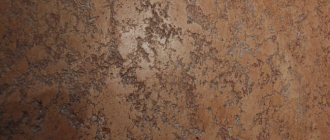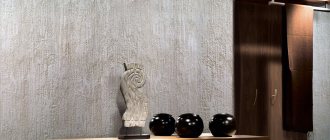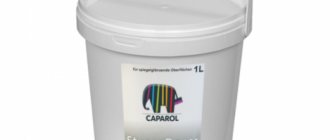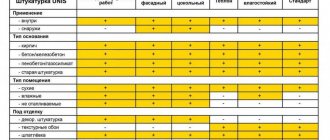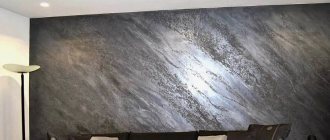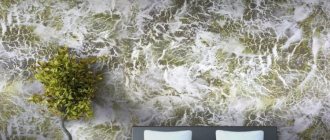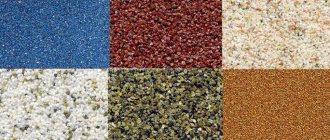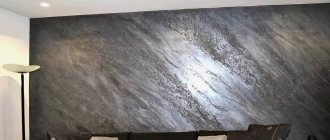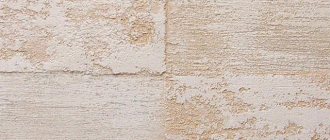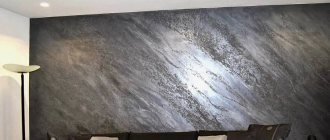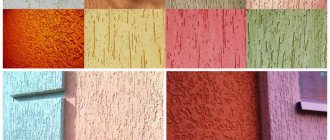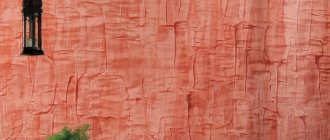What is "Bayramix"
Bayramix is a unique solution for facade and interior finishing from a Turkish manufacturer. For 24 years, decorative and finishing materials from the Interra Deco Group holding have been in great demand among craftsmen. IDG is committed to preserving the environment and uses high-quality hypoallergenic raw materials to produce its products.
Under the Bayramix brand, complex materials are produced for preparatory and finishing work on external and internal surfaces of walls and ceilings, namely:
- water-based facade and interior paints;
- liquid wallpaper;
- protective coatings, primers and impregnations;
- putties for sealing seams and leveling bases;
- textured and structural coatings;
- decorative plasters.
Work technology
If you chose Bayramix decorative plaster as a finish, then it should be applied to a previously prepared surface. All work that generates dust must be completed. In order to achieve a good result, work must be carried out in sufficient lighting. In order to avoid accidents, you must follow the rules for handling electrical appliances. They must be unplugged from the sockets. Only after the plaster has dried can the devices be turned on.
Plaster is applied using a metal float. The master should make forward movements, directing the tool from bottom to top. The composition in the required quantity is applied to the surface of the grater using a construction trowel. The mixture should be applied to the surface in an even layer; its thickness should not be impressive and depends on the fraction of the mixture. Decorative plaster "Bayramix", as practice shows, is consumed in a volume of 3.5-4 kg/m2. This applies to large factions. If we are talking about a composition with an average fraction of elements, then the consumption will be reduced to 1.8-2 kg/m2.
Grouting, or rather, adjustment, should be carried out no earlier than half an hour after applying the base layer. “Bayramix” - plaster, the photo of which is presented in the article, must be applied at a certain temperature. +5 °C will be enough to polymerize the layer. Under such conditions, drying time will last from a day to 48 hours.
Bayramix plasters
Bayramix finishing plaster mixtures are divided into several types.
- Marble. The base is an environmentally friendly polymer – acrylic resin. The key component is marble chips of various shapes, colors and sizes. Special weather-resistant, durable Bayramix plaster compositions have been developed for exterior work, as well as interior decoration.
- Venetian. Ideally reproduce the texture of natural stone: raw sandstone and limestone, the smooth surface of marble and granite, the unique effect of malachite and jasper. To achieve texture, it is recommended to apply the finished composition in 2 layers. Requires the application of a finishing coating - glaze paint.
- Textured. Decorative plaster mixture with a pebble effect. Performs several functions simultaneously - finishing and leveling bases, filling minor depressions and cracks.
Suitable bases for plastering with a polymer composition: concrete, expanded clay concrete, gypsum, asbestos cement, gypsum plasterboard, gypsum board, wood chips, wood fiber, oriented strands of fine and medium fractions, whitewashed, and also painted with oil paint.
Line of marble plasters
- Large marble chips with a mosaic effect. The coating includes large, unpolished marble granules in the color of natural stone. In total, the manufacturer offers 12 shades.
- Ball-shaped marble chips with a mosaic effect. Sanded granular grains of fine texture lie perfectly evenly on the surface of walls and ceilings. The catalog contains 24 color variations.
- Mineral with mosaic effect. The spherical granules are painted with an abrasion-resistant composition. It won’t be difficult to choose a material that perfectly matches the color – the range includes 56 shades.
- Savtash. Marble filler in the form of polished round granules. There are 36 possible “natural” colors to choose from.
- Luxory. Elite plaster mixture with marble chips, painted with metallized pigment. When dry, the plaster applied to the base has a distinctive luster with a lurex effect. The color palette includes 14 different shades.
- Mineral-Gold. Marble chips are coated with a light-resistant pearlescent dye that protects the coating from fading. Bayramix plaster is intended for interior work. The manufacturer limited the choice to a palette of 20 shades.
- I Stone. Textured plaster mixture with imitation of the color and rough surface of clastic rock - sandstone.
Line of textured plasters
- Gravol. When applied to a base, it resembles the “Fur Fur Coat” texture and is intended for tinting according to catalogs.
- Palta. The composition includes granite chips of different sizes. Suitable for computer tinting according to the tinting tables of the material.
- Bitera. The main component is large-sized marble granules to create the “Bark Beetle” texture.
- Teratex. Large format "Fur Fur".
- Teraflex. Plastic filler with special additives to create a thin-layer relief.
- Rulomix. Thin-layer coating with a “Fur Coat” structure.
- Rulosil. Moisture-resistant “Fur Fur” for exterior finishing with fine granules.
Types of materials and their features
Decorative plaster in the interior (photos of design options can be viewed on the page) looks very beautiful and unusual. And thanks to the variety of types, you can choose the most suitable option. Plaster is classified according to various criteria. However, most often it refers to the type of binder and filler. If we talk about the last parameter, then you can usually find the following types of decorative plaster on sale:
- textured
; - structural
; - Venetian
.
Textured plaster in the interior is most common. It is characterized by a highly viscous structure. Among the fillers there are flax fibers, wood, mineral chips, etc. You can choose any design of decorative plaster: bark beetle, lambskin, fur coat, wet silk, etc. The first option is distinguished by a grooved texture, reminiscent of wood eaten away by bugs. This option looks great in a country interior. In the bedroom, pastel shades of plaster for interior work will be relevant, and in the living room it is advisable to use darker colors. The “fur coat” subtype of material mainly consists of cement. After application to the wall, a rough surface with small fibers is obtained. Look how decorative plaster “fur coat” looks in the photo and how well it harmonizes with the rest of the interior.
There are other subtypes of textured material that imitate different surfaces. Decorative plaster “like wood”, “like leather” - you can choose any option for a classic or modern interior. The variety of colors and textures is quite large to realize the most non-trivial design ideas.
Decorative plaster for structural type interior work is created on an acrylic or silicate base. To form a certain texture, marble chips or quartz are added, due to which the finished surface becomes grainy. The material allows you to create various patterns of decorative plaster. Therefore, its use will be relevant for any room, regardless of the direction of the interior.
Venetian decorative plaster in the interior looks the most luxurious and rich. It is distinguished by its smooth surface, which can be glossy or matte. The finished work resembles marble or onyx finishing, but application requires special skill. Most often, decor with such plaster is used in apartments and houses created in the classical or “Baroque” direction. It is enough to choose colors that suit the overall ensemble and decide on the type of imitation (stone, precious metals, etc.).
Advantages of Bayramix plaster
A unique set of characteristics of decorative and finishing products sets Bayramix apart from its analogues:
- Environmental friendliness;
- Frost resistance;
- Strength;
- Abrasion resistance;
- Long service life;
- Wear resistance;
- Protection of the base from destruction;
- Weather resistance;
- Fade resistant;
- Ease of operation and subsequent operation;
- Wet cleaning is allowed, including using detergents.
Advantages
The main advantages of Bayramix include the following technical and operational characteristics:
- Durability and excellent mechanical strength.
- High level of manufacturability (small losses during application, good adhesion and wipeability).
- Variety of textures and colors.
- Resistant to high humidity, temperature fluctuations, ultraviolet radiation and alkalis.
- Ecological cleanliness.
- Easy to apply without the need for tedious preparation work.
- Resistance to treatment with a 10% chloramine solution (due to this quality, plaster is often used for finishing walls in medical institutions).
Wall finishing stages
Unlike Venetian decor, texture and structural compositions have fewer requirements. Regardless of the chosen finishing material, before applying Bayromix plaster, it is necessary to carry out a full-stage preparation of the walls.
- For interior and exterior decoration - remove all switches and sockets from the work surface, remove lamps and decorative elements.
- Clean the surface of the old coating, degrease, level the base and fill any cracks that have formed.
- Prime the working area for better adhesion of the putty to the base.
- Apply a thin layer of finishing putty.
- Prime with a special acrylic compound.
- Sand with fine-grit sandpaper.
You can begin finishing the walls a day after the preparatory stages.
Note. The use of putty before applying thick-layer relief coatings is optional.
Example of calculating layer thickness
For example, we need to apply a solution to a wall with an area of ten m2, the unevenness of which reaches 5 cm. We select three points on the wall and measure the deviations. As a result, we get deviations of one, three and five centimeters. We sum up the results obtained and get 9 cm. Divide the sum by the number of points and get 3 cm. As a result, in order to evenly treat the wall, you will need to apply an average layer of 3 cm. In this case, 1 cm will be the thinnest layer, and 5 cm will be the thinnest thick. Also do not forget that with beacons installed, the minimum layer thickness will be 6 mm.
As a result of the calculations, we will determine what layer size is needed to evenly finish the wall with decorative plaster. Next, you will need to find out recommendations from the solution manufacturer. As mentioned earlier, the packaging indicates the consumption for processing 1 m2 in a one-centimeter layer. If you purchased high-quality decorative plaster from a reputable company, then there should be no problems with calculations.
Application technique
- Preparing the mixture. Stir the prepared paste thoroughly before use. Dry - mix with water in the proportion specified in the instructions. For mixing, use a drill with a construction mixer in the form of an attachment.
- Application. Decorative plasters are applied to the base that is completely dry after the primer layer. Work is carried out without beacon profiles, even when applying thick-layer facade coatings. Marble plaster is applied in 1 layer with a thickness of 1.5-2 granules and leveled with a trowel or a construction trowel. Venetian plaster is applied in 1-2 layers. The first is to distribute the solution evenly over the working surface, creating a relief texture using a textured roller, trowel, applicator or tampon. Textured plaster is spread over the surface with a spatula or spray gun. Uniform spreading of the solution followed by imparting the required relief is done with a trowel, mesh roller or brush.
- Coating care. Wet care using detergents is allowed. The final step is to rinse the surface with a sponge soaked in water.
Specifications
Turkish marble plaster is a composite decorative material for interior and exterior walls. Despite the very affordable cost, this type of finishing is a worthy product that has a number of positive qualities. The mixture can be applied to substrates of any complexity - concrete, plasterboard sheets, wood material, acrylic and water-based paints. The mixture is filled with marble chips of various shapes, sizes and colors. The connecting link is an acrylic polymer compound.
This is a high-strength synthetic resin, absolutely safe for work and use.
The coating has undoubted advantages over similar finishing products:
- the plaster has high strength and is resistant to physical influences, so you can use a brush or vacuum cleaner for washing;
- the mixture has high plasticity and lightness, and thanks to the addition of mineral components, additional load on the walls during finishing is eliminated;
- despite the presence of polymer compounds, the composition is harmless to the health of people and pets;
- the product is moisture resistant, does not corrode, and prevents the appearance of fungus and mold;
- the solution is made for long-term use, insensitive to ultraviolet radiation, critical temperatures and frost.
In addition, you can always choose any color and special decor that suits a specific room. The price of this product is also pleasing, quite low for the excellent quality.
How not to apply Bayramix
Neglecting the application technology developed by the manufacturer entails the following consequences:
- Failure to follow the technique for applying Bayramix marble plaster leads to the formation of seams on the dried surface and gaps due to the uneven distribution of the mixture on the base.
- Failure to comply with the recommended temperature and humidity for plastering walls with Bayramix can lead to peeling of the mixture. A low temperature will not allow the material to set; too high a temperature will lead to the formation of cracks even with the use of reinforced reinforcing mesh.
- Before plastering work, it is necessary to treat the surfaces with primer. This will prevent the plaster from taking moisture from the base when drying. Otherwise, cracks will form on the coating.
- Depending on the Bayramix paste plaster mixture used, the applied coating requires wetting once a day, especially in hot weather.
- If work is planned on the facade, it is recommended to avoid direct sunlight. To protect the coating, 3 hours after applying the plaster, cover the surface with plastic film. This will not allow moisture to evaporate, which will protect the base from cracking.
- Incorrect mixture calculation. Each paste for plastering walls has an individual consumption. It is recommended to add from 5% to 10% to the calculated area and buy the entire volume at once. It is not recommended to split the purchase into several parts due to the fact that the seller may not have the finishing material or the appropriate colorant.
- Failure to comply with the proportions of water to dilute the dry mixture. A solution that is too thick will not adhere well to the base; an overly diluted solution will not meet the stated characteristics of the prepared product.
- You can’t add dry mixture to the water – then it’s difficult to get rid of lumps.
Preparation
The plaster material must be applied to the prepared surface. The base must be level, clean and dry. There should be no chips or cracks on it. If you are going to apply Bayramix plaster to a metal surface, first remove any corrosion (if any) from it and apply an epoxy or alkyd coating.
If there is an old paint coating on the base, the chemical composition of which you do not know anything about, you will need to apply putty with drying oil. Treat the surface with copper sulfate, alkyd material
. This will prevent color stains from appearing in the future. Before applying the plaster composition, a primer should be used.
During finishing work, the room should not be too cold and humid. It is not recommended to work in rainy weather.
